Father Lazar of Serbia Successor Durad Brankovic Name Stefan Lazarevic | Role Lazar of Serbia\'s son House House of Lazarevic | |
 | ||
Died July 19, 1427, Mladenovac, Serbia Parents Princess Milica of Serbia, Lazar of Serbia Siblings Olivera Despina, Vuk Lazarevic Grandparents Vratko Nemanjic, Pribac Hrebeljanovic Similar People | ||
Natpis na mramornom kosovskom stubu sv despot stefan lazarevic muzika djordje ilijin
Stefan Lazarević (Serbian: Стефан Лазаревић, c. 1377–19 July 1427) known also as Stefan the Tall (Стеван Високи), was the son of Prince Lazar Hrebeljanović and a ruler of Serbia. He held a title of prince (1389-1402) and despot (1402-1427). In his time he was regarded as one of the finest knights and military leaders in Europe, and because of his literature works he is regarded as one of the best Serbian writers in the Middle ages. After the death of his father on the Kosovo Field in 1389, he became ruler of Moravian Serbia and ruled with his mother Milica Hrebeljanović, until he reached adulthood in 1393. His reign and his personal literary works are sometimes associated with early signs of the Renaissance in Serbian lands. He introduced knightly tournaments, modern battle tactics, and firearms to Serbia.
Contents
- Natpis na mramornom kosovskom stubu sv despot stefan lazarevic muzika djordje ilijin
- The manasija monastery an endowment of serbian ruler stefan lazarevi
- Background and family
- Life
- Works
- Resava School
- Titles
- Marriage
- References
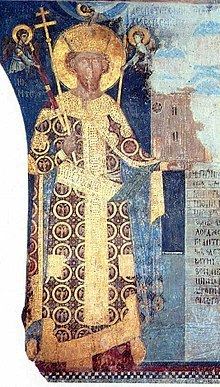
As an Ottoman vassal, Lazarević was leader of Serbian auxiliary squads in the battle of Rovine, Nicopolis and Angora. After the battle of Angora, Lazarević received the title of despot from the Byzantines in Constantinople, in 1402. He sent troops to support the Ottoman army at the Battle of Carmorlu which consolidated the Ottoman power thus unintentionally paving the way for complete conquest of his country some times later.
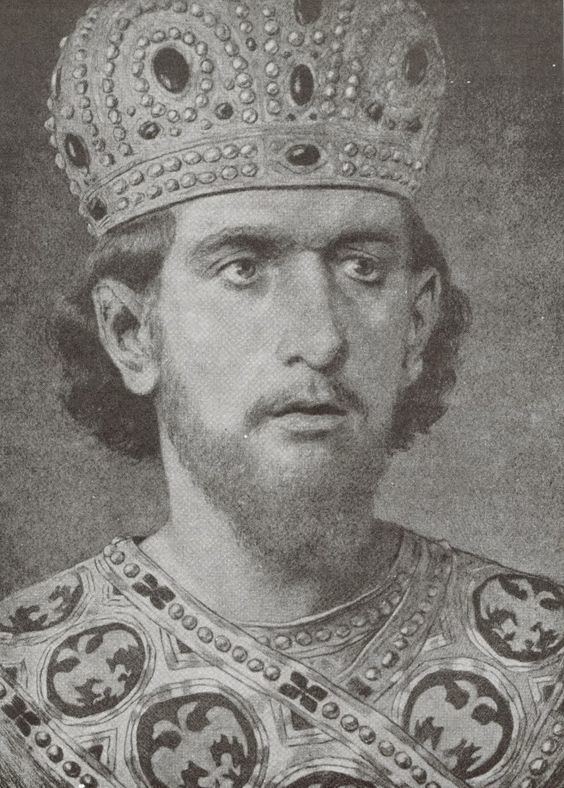
In 1403–04 he became an ally of Hungarian king Sigismund, and received Mačva, Belgrade (which became Lazarević's capital in 1405), Golubac and other domains, such as Srebrenica in 1411. In 1408 Sigismund founded the Order of the Dragon, a chivalric order for selected nobility, in which Stefan had the superior rank.
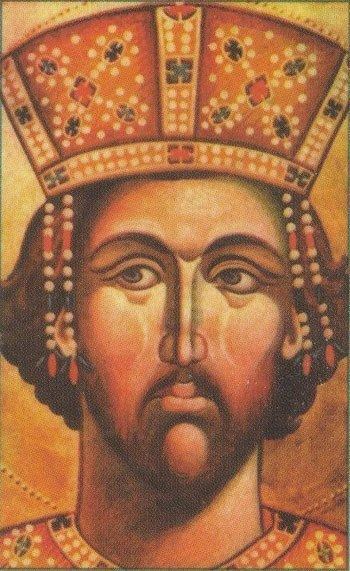
After the Ottoman defeat on Angora, civil war erupted in the Ottoman Empire, while clashes among Serbian nobility ensued. First, between Lazarević and Branković, secondly between Stefan and his younger brother Vuk. The clashes among the nobility ended in 1412, with the conciliation of Stefan and his nephew Đurađ Branković. After the death of Balša III Balšić, he inherited Zeta and waged the war against Venice. Since he did not have any children, on the assembly in Srebrenica (1426), Stefan proclaimed his nephew Đurađ as heir.
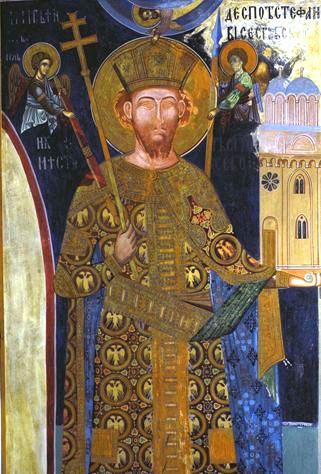
On the domestic front, he broke the resistance of the Serbian nobles, and used the periods of peace to strengthen Serbia politically, economically, culturally and militarily. On 29 January 1412 he issued the "Code of mines" (Законик о рудницима), with a separate section on governing of Novo Brdo – the largest mine in the Balkans at that time. This code increased the development of mining in Serbia, which has been the main economic backbone of Serbian Despotate. At the time of his death, Serbia was one of the largest silver producers in Europe. In the field of architecture, he continued development of Morava school.
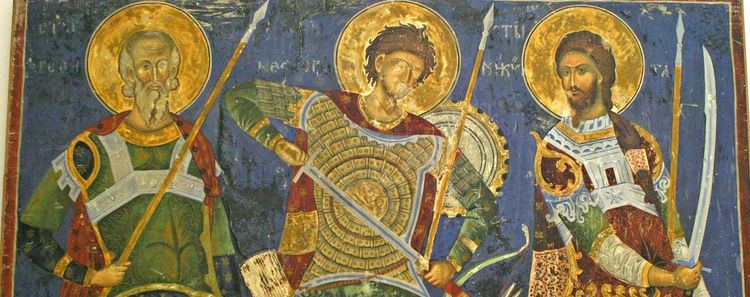
He was a great patron of the arts and culture by providing shelter and support to scholars from Serbia, and refugees from neighboring countries that have been taken by the Ottomans. In addition, he was himself a writer, and his most important work is A Homage to Love, which is characterized by the Renaissance lines. Beside despot’s literature work, in this period there were other authors such as Euthymius of Tarnovo, Cyprian, Metropolitan of Kiev, Constantine the Philosopher, and Gregory Tsamblak. During his reign the Resava school was formed.
The manasija monastery an endowment of serbian ruler stefan lazarevi
Background and family
Stefan was the son of Lazar and his wife Milica, a lateral line of Nemanjić. Hrebeljanović's father Prince Vratko was a direct descendant of Vukan, eldest son of Stefan Nemanja. In addition to Stefan, they had seven other children.
Stefan Lazarević married Jelena in September 1405. Jelena was daughter of Francesco II Gattilusio, a Genovese lord of Lesbos and a sister of Irene Gattilusio, empress of Byzantium empire and a wife of John VII Palaiologos. This marriage was arranged during his stay in Constantinople in 1402, at a time when the city and the Byzantine Empire ruled John VII in the name of his uncle, Manuel II (1373-1391 ruler, Emperor 1391-1425). Jelena and Stefan had no children and Jelena is not shown on any frescoes in monasteries built by Stefan.
Life
Stefan was the son of Prince Lazar, whom he succeeded in 1389. Nikola Zojić attempted to overthrow Stefan Lazarević at the end of 14th century and used Ostrvica as haven after his attempt failed. Lazarević participated as an Ottoman vassal in the Battle of Rovine in 1395, the Battle of Nicopolis in 1396, and in the Battle of Ankara in 1402.
He became the Despot of Serbia in 1402 after the Ottoman state temporarily collapsed following Timur's invasion of Anatolia with the Battle of Ankara, where he and his Serbian Knights fought well and a good portion of his forces survived. While stopping at Constantinople on his way home, he was well received by the Emperor who granted him the title of Despot by which he was to be known from then on and by which his successors were also to be known. At first Stefan's policy seems to have been to take advantage of Ankara to shed Ottoman vassalage and to assert Serbia's independence. Stefan's nephew George Brankovic who had no love for Stefan soon lined up with Suleyman a son of Bayezid (Ottoman Sultan 1389-1402) against Stefan.
Stefan was receptive when Sigismund of Hungary approached him for an alliance. Sigismund was very generous in his terms. He offered Stefan Lazarevic Macva including Beograde for Stefan's lifetime if he would accept Hungarian suzerainty for it. In the interim, In November 1402 Stefan defeated Brankovics's forces (which included troops from Suleyman) at Tripolje. At this time Stefan also acquired from Sigismund the important fortress of Golubac on the Danube. In 1403 he proclaimed Belgrade his capital. He built a fortress with a citadel which was destroyed during the Great Turkish War in 1690; only the Despot Stefan Tower remains today. In 1404, Sigismund gave Lazarević land in the present-day Vojvodina (and Pannonian part of present-day Belgrade), including Zemun (today part of Belgrade), Slankamen, Kupinik, Mitrovica, Bečej, and Veliki Bečkerek. In 1417, Apatin is also mentioned among his possessions.
Under his rule, he issued a Code of Mines in 1412 in Novo Brdo, the economic center of Serbia. In his legacy, Resava-Manasija monastery (Pomoravlje District), he organized the Resava School, a center for correcting, translating, and transcribing books.
Stefan Lazarević died suddenly in 1427, leaving the throne to his nephew Đurađ Branković. His deeds eventually elevated him into sainthood, and the Serbian Orthodox Church honors him on 1 August. Despot Stefan is buried in the monastery Koporin which he had built in 1402, as he did the bigger and more famous Manasija monastery in 1407. In fact, Manasija was intended as his own burial place, but due to a sudden nature of his death in perilous times it was his brother Vuk that is buried there.
Works
Apart from the biographical notes in charters and especially in the Code on The Mine Novo Brdo (1412), Stefan Lazarević wrote three original literary works:
He was probably the patron of the most extensively illuminated Serbian manuscript, the Serbian Psalter which is now kept in the Bavarian State Library in Munich.
Resava School
Despot Stefan Lazarević was a great patron of art and culture providing support and shelter to scholars from Serbia and exiles from surrounding countries occupied by the Ottomans. He was educated at his parents’ home, he spoke and wrote Serbo-Slavic; he could speak Greek, and was familiar with Latin.
He was an author in his own right, and his main works include "Slovo ljubve" (Letter of Love) that he dedicated to his brother Vuk and "Natpis na mramornom stubu na Kosovo" (Inscription on the Marble Pillar at Kosovo). Some of the original works he wrote during his reign have been preserved. During the Despotʼs reign, rich transcribing activity – The Transcription School of Resava – was developed in his foundation, the Manasija Monastery. More Christian works and capital works of ancient civilization were transcribed there than in all times preceding the Despotʼs ruling. By building a spiritual shield to his nation, bequeathing rich spiritual heritage and values rooted in Christian civilization, Despot Stefan made it possible for future civilizations to find own spiritual roots, deeply aware that historical recollection cannot exist without linguistic memory.
During the short time the life of the founder and monastery coincided (1407-1427), so much was achieved in Resava that it remained an important and outstanding monument in the history of Serbian and Slavic culture in general. It was there that Bulgarian-born Constantine the Philosopher, a reputable "Serbian teacher", translator and historian established the famous orthographic school of Resava, in order to correct errors in the ecclesiastical literature incurred by numerous translations and incorrect transcriptions, and to thoroughly change the previous orthography.
Constantineʼs essay on how Slavic books should be written recommended a very complicated orthography that subsequently many authors adopted and used for a long time. Regardless of subsequent criticism of this endeavour, the very fact that in Serbia in the 15th century an essay was written on orthography and its rules is very important. But the writing and translation works in Manasija are even more important. Until the very end of the 17th century documents confirm outstanding reputation or translations and transcripts originating from the Resava School.
Titles
Marriage
On 12 September 1405, Stefan married Helena Gattilusio, the daughter of Francesco II of Lesbos. According to Konstantin the Philosopher, Stefan first saw his wife on Lesbos, where Francesco II offered him a choice among his daughters; the marriage was arranged "with the advice and participation" of Helena's sister, Empress Eirene. Surprisingly, there is no mention of Helena after her marriage to Stefan; this led Anthony Luttrell to remark that "apparently there were never any children; nothing is known of her death or burial; and, most unusual, she did not appear in any of the post-1402 fresco portraits of Stefan". Luttrell concludes "Maybe she was too young for the marriage to be consummated, and perhaps she stayed on Lesbos and never traveled to Serbia; possibly she died soon after her marriage."
